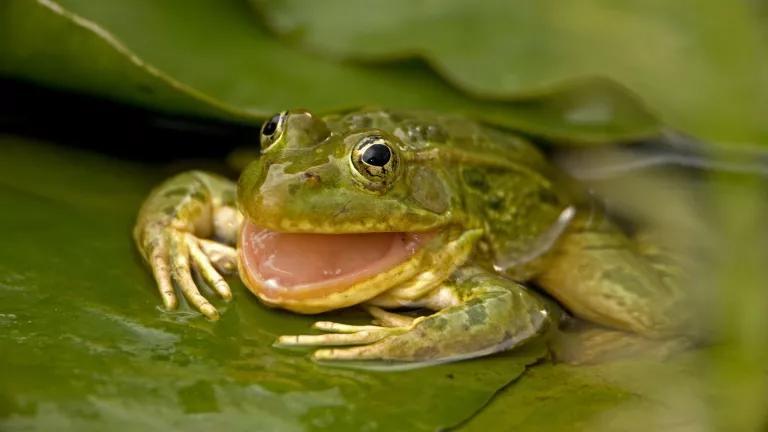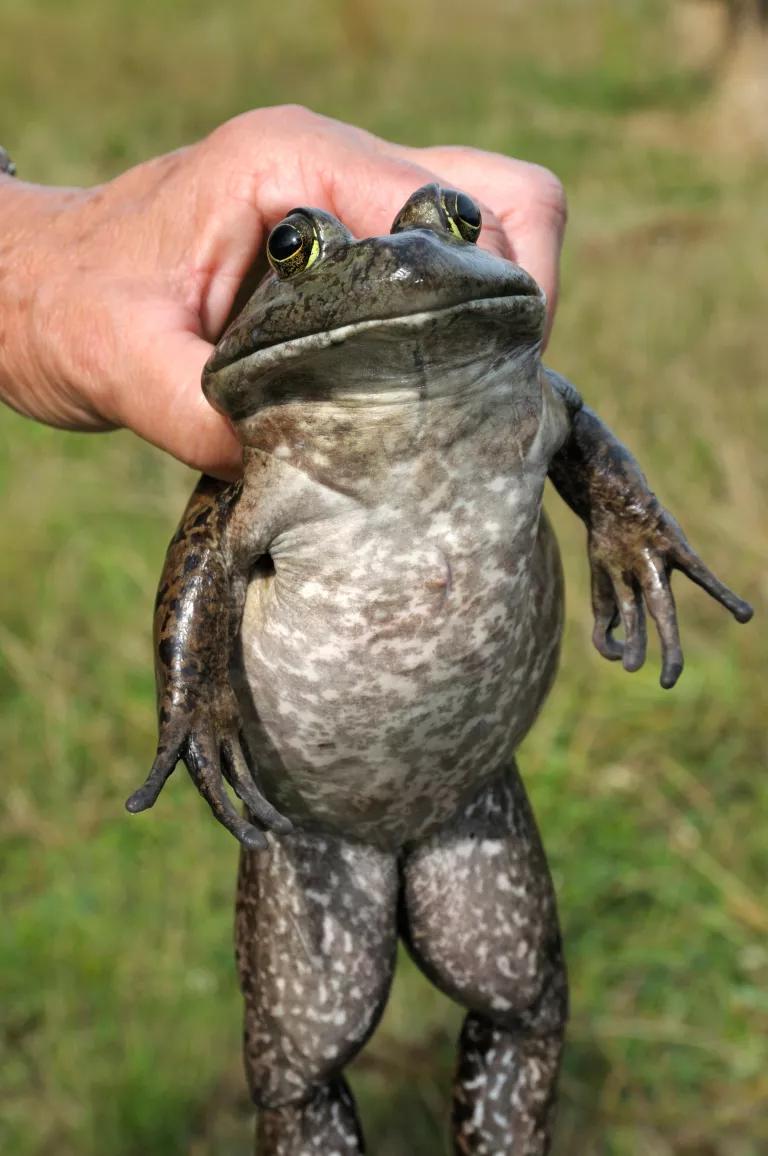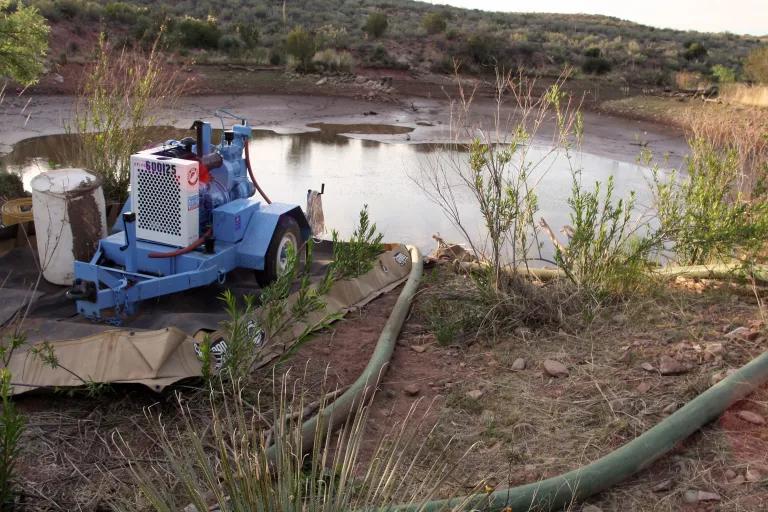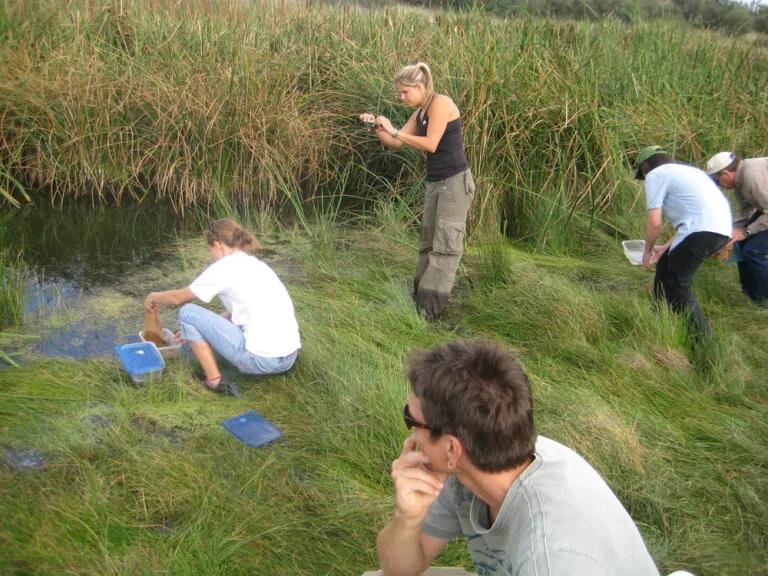The Bullfrog Is the “Great White Shark” of Arizona’s Wetlands
Conservationists and ranchers are teaming up to drain the swamp (literally) so they can kick these invasive croakers out and save the state’s leopard frogs.

A Chiricahua leopard frog
A century and a half ago, when Geronimo and his men walked through Arizona’s Chiricahua Mountains at night, a chorus of leopard frogs would have greeted them. Whether the Apaches enjoyed it, though, is unknown. Frankly, the song sounds a lot like snoring.
In any event, over the course of the 20th century this froggy log-sawing became a rare sound. Housing developments paved over the species’ wetlands. Cattle ranches sullied their waterways. And in this century, the mysterious chytrid fungus devastating amphibian populations all over the globe has also struck this corner of the Southwest. In the past 15 years alone, the Chiricahua leopard frog population has declined more than 30 percent.
But the greatest threat to these adorably spotted snorers might come from one of their own: the American bullfrog.
At up to eight inches in length, American bullfrogs are twice the size of Chiricahua leopard frogs, and the former has no qualms about eating the latter for dinner. Gulp. In fact, these bullfrogs can take down everything from bats, wading birds, and rattlesnakes, to tarantulas and the wasps that hunt them. (Biologist Justin Schmidt describes the wasps’ sting to feeling like dropping a hairdryer into your bubble bath).
Though American bullfrogs are American, they are not native to this region. Historically, the species’ range included almost everywhere east of the Rocky Mountains, but it wasn’t until humans started introducing the chunky frogs all over the west that the species made the, er, leap over the mountain range. (People have also brought them to parts of Europe, Asia, and South America, where they also have become ecological nightmares.)

Why bring a frog anywhere? I wish I could say there was a better reason, but really, people just like to eat frog legs. And it wasn’t some misguided settlers bringing their favorite food with them on the journey west. No. The goldarned Arizona Game and Fish Department purposefully introduced American bullfrogs into state wetlands starting in the 1920s and continuing all the way up to 1982.
In addition to being what ecologist Cecil Schwalbe calls “the great white shark of inland waters,” American bullfrogs are prolific breeders. A single female can drop around 20,000 eggs in a gelatinous cloud at the water’s surface. So once the frogs establish themselves in a new ecosystem, removing them becomes a Herculean feat.
But not an impossible one.
“It’s really hard to get rid of bullfrogs,” says Michele Lanan, resident research scientist at the American Museum of Natural History’s Southwestern Research Station. “They’re so hardy. They’re really difficult to kill.”
Lanan says the best way to get an American bullfrog out of a wetland is actually to make the wetland disappear—temporarily, of course. “We get these big, gas-powered pumps and we suck out the water and dump it where it can dry out,” she says. “We do that for days until it’s totally down to the mud.”
To reduce the amount of collateral damage to the ecosystem, Lanan and her fellow scientists send native species like Arizona mud turtles, dragonfly larvae, and even endangered desert pupfish on a little vacation. They use a seine net to capture every last bullfrog tadpole they can find, and then, because bullfrogs can survive a surprisingly long time buried in wet mud, they let the Arizona sun bake the pond’s bottom to a crisp. Afterwards, the scientists pump new water back in and return the natives.
This scorched-earth bullfrog removal strategy may sound extreme, but it allowed scientists with the FROG Conservation Project to remove bullfrogs from some 444 square miles of southeastern Arizona. They strategically chose each habitat to create a swath of safe zones that were not only bullfrog-free, but also far enough away from infested wetlands that could serve as launchpads for new invasions. A bullfrog buffer zone, if you will.

With the coast now clear, the project has reintroduced about 20,000 Chiricahua leopard frogs to more than 80 sites in the state. The U.S. Fish and Wildlife Service still lists the species as threatened, but the project’s progress has been impressive.
“It had never been accomplished before,” says Dennis Caldwell, a biologist with the FROG Conservation Project. Caldwell focused on the Cienega Creek watershed, a valley that encompasses hundreds of square miles of habitat.
According to Caldwell, the efforts of the conservationists might not have been as successful without the help of ranchers. Many of the Chiricahua leopard frog reintroductions were kicked off in the artificial cow ponds ranchers use to keep their livestock hydrated. The conditions in these ponds were much easier to control than were swampy, vegetation-choked natural waterways. (Whether or not to regulate cow ponds, and other seasonal bodies of water, under the Clean Water Act is currently the subject of much debate.)
“I think ranchers often get a bad rap when it comes to conservation, but the ones we’ve worked with have been very good stewards,” says Caldwell. “I really don’t think that this species would still be around if it weren’t for these livestock watering holes all over southern Arizona.”

Cow ponds also tend to attract a certain kind of insect. “If there’s one other thing we’ve learned about cows and frogs, it’s that frogs love to eat flies, and cows produce flies like crazy,” says Caldwell.
The ranchers’ ponds have served as launchpads for leopard frogs to retake the whole of the valley. We know this because the researchers nipped off a digit from each frog so they could check for the presence of chytrid fungus and perform DNA analyses. The researchers removed a different finger for each frog locale and have since been able to use this as an indicator of where any given frog has come from. (It turns out that Chiricahua leopard frogs get around. One frog hopped 11 miles away from the cow pond it grew up in.)
“It’s certainly been a lesson in ecology for me,” says Lanan. “Each pond is an ecosystem, and each ecosystem is a little bit different.”
But all of those wetlands have at least one thing in common now—the sweet, snoring sounds of success.
This article was originally published on onEarth, which is no longer in publication. onEarth was founded in 1979 as the Amicus Journal, an independent magazine of thought and opinion on the environment. All opinions expressed are those of the authors and do not necessarily reflect the policies or positions of NRDC. This article is available for online republication by news media outlets or nonprofits under these conditions: The writer(s) must be credited with a byline; you must note prominently that the article was originally published by NRDC.org and link to the original; the article cannot be edited (beyond simple things such grammar); you can’t resell the article in any form or grant republishing rights to other outlets; you can’t republish our material wholesale or automatically—you need to select articles individually; you can’t republish the photos or graphics on our site without specific permission; you should drop us a note to let us know when you’ve used one of our articles.

Protecting Biodiversity Means Saving the Bogs (and Peatlands, Swamps, Marshes, Fens…)
The Long, Long Battle for the Arctic National Wildlife Refuge
In Planning for Climate Change, Native Americans Draw on the Past